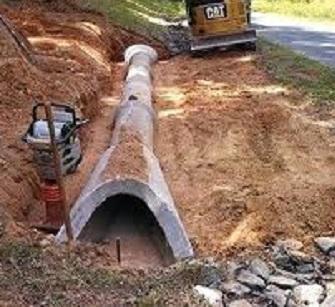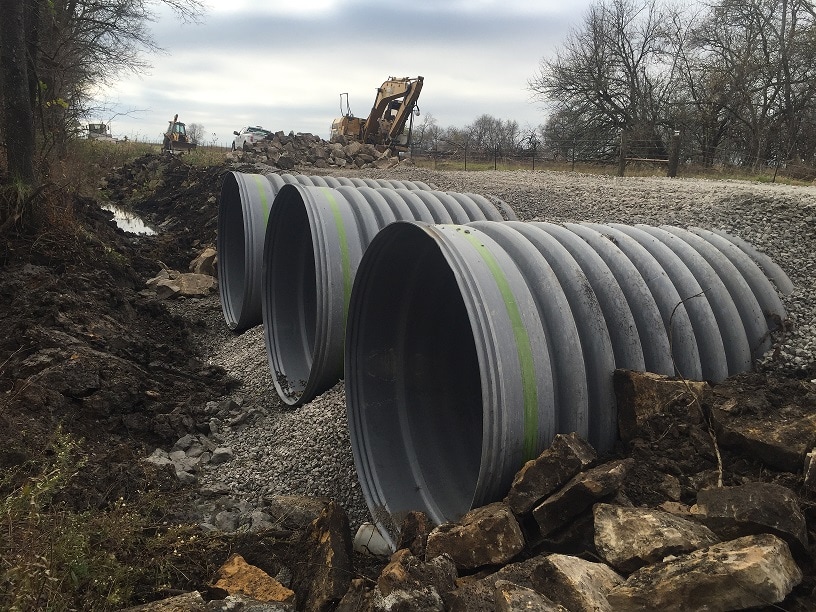Culvert Installment Made Easy: Step-by-Step Guide for Success
Mounting culverts might appear like a straightforward task, yet making sure an effective outcome requires mindful preparation and execution. From choosing the ideal culvert dimension to incorporating proper water drainage procedures, each action in the installment procedure plays an important function in the functionality and longevity of the culvert system. By complying with a systematic technique and paying attention to crucial information, the installation can continue smoothly, minimizing prospective issues down the line. Remain tuned to uncover the important actions and considerations that can make culvert installment a smooth and effective endeavor.
Picking the Right Culvert Dimension
Selecting the appropriate culvert dimension is important for guaranteeing efficient water circulation and architectural stability in culvert setup projects - Pad Construction. The size of the culvert directly impacts the flow capability of water with the structure. A culvert that is also little can result in flooding and overflow, while one that is too big might lead to reduced water speed, possibly causing debris accumulation and obstructions
To determine the appropriate culvert dimension, elements such as the watershed location, height flow rates, and hydraulic performance demand to be thoroughly taken into consideration. Computations based upon these criteria aid in selecting a dimension that can sufficiently manage the anticipated water volume while reducing the threat of blockages and structural failure.
It is vital to consult design standards and standards to guarantee that the selected culvert size fulfills the project needs and regional laws (Pad Construction). By selecting the best culvert size, project supervisors can enhance water circulation, prevent possible issues, and enhance the overall performance and long life of the culvert installment
Preparing the Installation Website
Efficient culvert installment demands precise preparation of the setup website to make sure optimal structural support and performance. Before starting the setup procedure, it is important to get rid of the website of any debris, vegetation, or blockages that can hinder the culvert's placement. Making sure a level structure is necessary for the proper alignment and security of the culvert. This may entail rating the site to produce a smooth, even surface that can effectively support the weight of the culvert and any kind of awaited loads. In addition, proper compaction of the dirt below the culvert is needed to avoid working out or changing over time.
In addition, it is essential to consider elements such as soil structure, groundwater degrees, and environmental influences when preparing the installment site. Conducting a thorough Full Article site analysis can assist recognize any type of possible difficulties or threats that may impact the culvert's efficiency. By taking the time to prepare the setup website properly, you can help guarantee an effective culvert setup that fulfills structural needs and makes sure long-term performance.
Positioning the Culvert Properly

The grade at which the culvert is placed is essential for keeping an appropriate incline for water circulation. Furthermore, the culvert needs to be oriented properly to make sure that the inlet and outlet are in the correct areas. Pad Construction.
Backfilling and Condensing the Dirt
Correct backfilling and compaction of the soil around the culvert is crucial to make certain stability and prevent prospective issues in the future. As soon as the culvert is properly put, the next crucial step is to backfill the location around it with ideal check this site out material.
After putting the backfill product, it is essential to portable it in layers of consistent thickness. Utilizing a compactor or a mechanical meddle, portable the soil delicately to prevent damaging the culvert. Compaction helps in minimizing the opportunities of negotiation and ensures uniform support around the culvert. It is vital to compact the dirt evenly on all sides of the culvert to keep its structural integrity.
Proper backfilling and compaction not only offer security to the culvert however additionally help in protecting against soil erosion and keeping the durability of the culvert system.
Ensuring Correct Drain Assimilation
Integrating efficient drainage solutions plays an important function in the general functionality and longevity of culvert installations. Appropriate drain assimilation is essential for taking care of water flow, preventing disintegration, and guaranteeing the architectural honesty of the culvert system. To accomplish this, it is crucial to develop a thorough drain strategy that considers factors such as the volume of water anticipated, the topography of the area, and the type of dirt existing.

In addition, incorporating functions like erosion control procedures, such as riprap or greenery, can even more boost the effectiveness of the water drainage system. By carefully preparing and implementing these drainage solutions, culvert installations can function efficiently and withstand the examination of time.
Final Thought
To conclude, correct culvert setup is essential for maintaining efficient drainage systems. By picking the ideal culvert size, preparing the installment site, positioning the culvert appropriately, backfilling and compacting the soil, and ensuring appropriate drain assimilation, success can be accomplished. Adhering to these actions will aid ensure the long life and efficiency of the culvert, ultimately adding to the overall success of the drainage system.